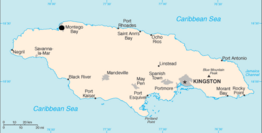Montego Bay
| Montego Bay | |
 |
|
 |
|
| Coordinates: | |
| Country | |
|---|---|
| County | Cornwall |
| Parish | St. James |
| Proclaimed city by act of Parliament | 1980 |
| Government | |
| - Mayor | Charles Sinclair (Mayor) |
| Population (2001) | |
| - Total | 96,488 |
| - St. James Parish | 175,127 |
| Time zone | EST (UTC-5) |

Montego Bay is the second largest city in Jamaica and is the location of Jamaica's largest airport, the Sir Donald Sangster International Airport.
Montego Bay is known for its duty free shopping and cruise line terminal at its Free Port on a beautiful, man-made peninsula jutting into the bay. Its sheltered Doctor's Cave Beach with clear turquoise waters is one of the most famous beaches on the island. The bay is surrounded by picturesque low mountains.
Montego Bay is third in population to Kingston and Spanish Town St. Catherine with about 230,000 people and lies in St. James Parish on the northwest coast of the island. Air Jamaica and several American and British airlines run their Caribbean hub in "MoBay" (Sangster International Airport) connecting the island with the United States, the United Kingdom, Germany, and recently Canada with flights to Toronto and Montreal. The southern U.S. city of Miami can be reached within 70 minutes. The southern U.S. cities of Charlotte, Houston, Atlanta, and Tampa are reached by nonstop flights in less than three hours. Other locations like New York City, Boston, Washington D.C., and Chicago are reached in under four hours.
The name "Montego Bay" is believed to have originated as a corruption of the Spanish word manteca ("lard"), allegedly because during the Spanish period it was the port where lard, leather, and beef were exported. Jamaica was a colony of Spain from 1511 until 1655 when Oliver Cromwell's Caribbean expedition, the Western Design, drove the Spanish from the island. Christopher Columbus, when he first visited the island in 1494, named the bay Golfo de Buen Tiempo ('Fair Weather Gulf')
During the epoch of slavery, from the mid-17th century until 1834, and well into the 20th century, the town functioned primarily as a sugar port. The island's last major slave revolt, the Christmas Rebellion or Baptist War (1831–1832) took place in the area around Montego Bay; the leader of the revolt, Samuel Sharpe, was hanged there in 1832. In 1975, Sharpe was proclaimed a national hero of Jamaica, and the main square of the town was renamed in his honour.
In 1980, Montego Bay was proclaimed a city by act of parliament, but this has not meant that it has acquired any form of autonomy as it continues to be an integral part of St. James parish.
Today, the city is known for its large regional hospital (Cornwall Regional Hospital), port facilities, second homes for numerous upper class Jamaicans from Kingston as well as Americans and Europeans, fine restaurants, and shopping opportunities. The coastland near Montego Bay is occupied by numerous tourist resorts, most newly built, some occupying the grounds of old sugar cane plantations with some of the original buildings and mill-works still standing. The most famous of these are the White Witch's Rose Hall and Tryall, both of which now feature world-class golf courses.
The Infrastructure of the City of Montego Bay is going through a series of explosive modernizations which once completed will aim to make the city the top destination in the Caribbean.
Montego Bay, Jamaica is one of the top resort destinations in the Caribbean because of the depth and beauty of its attractions and the wide variety of hotel choices ranging from 3 Stars such as Sandals and Breezes to 5 Star posh hotels like the Ritz Carlton, Half Moon, Round Hill and so on.
In Popular Culture
It was the set of movies such as How Stella Got Her Groove Back. The home of Reggae Sumfest and Air Jamaica Jazz and Blues. The city was the subject of the namesake song by Bobby Bloom in 1970, later covered by Jon Stevens ten years later, and was revived by Amazulu to became a minor hit in the U.S. in September 1986.
A large section of the book Rule of the Bone by Russell Banks takes place in Montego Bay.